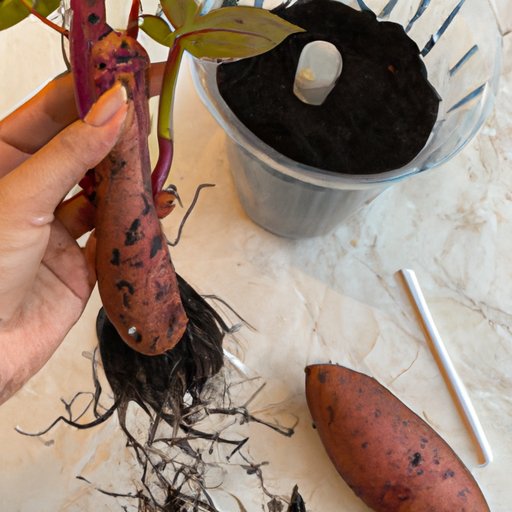Introduction
Growing sweet potatoes is a great way to get into gardening and enjoy delicious, nutrient-packed vegetables. Sweet potatoes are easy to grow, require minimal maintenance, and can be harvested in just a few months. To get started, you’ll need to know the basics of starting a sweet potato plant. This article will provide an overview of the steps involved in growing sweet potatoes from scratch, as well as some helpful tips for success.

How to Plant a Sweet Potato in 3 Steps
The first step in starting a sweet potato plant is to choose the right variety. Sweet potatoes come in many different shapes, sizes, and colors, so it’s important to select the one that best fits your needs. Once you’ve chosen the variety, the next step is to prepare the soil. Sweet potatoes prefer loose, well-draining soil with plenty of organic matter. Finally, plant the sweet potato by burying it about two inches deep in the soil. Water the soil thoroughly to ensure the sweet potato is properly hydrated.
Growing Sweet Potatoes from Scratch: A Step-by-Step Guide
If you’d like to skip the hassle of starting a sweet potato plant from seed, you can purchase sweet potato slips. Slips are young sweet potato plants that have already been grown from cuttings. To begin, purchase slips from your local garden center or online. Once you have the slips, follow these steps to get started:
- Step 1: Plant the slips in a sunny location with loose, well-draining soil. Make sure to space them a few inches apart.
- Step 2: Water regularly and fertilize every few weeks to keep the plants healthy and strong.
- Step 3: Harvest the sweet potatoes when they’re ready, usually after about three months.
Planting Sweet Potatoes: Everything You Need to Know
When planting sweet potatoes, it’s important to choose the right location. Sweet potatoes prefer full sun, so make sure to pick a spot that gets at least six hours of direct sunlight per day. Additionally, sweet potatoes thrive in warm climates, so if you live in a cooler area, consider planting them in pots so they can be moved indoors during cold weather. If you’re planting sweet potatoes outdoors, consider companion planting with other vegetables such as corn, beans, and squash to maximize the space in your garden.
Once you’ve planted the sweet potatoes, proper care is essential for a successful harvest. Sweet potatoes need plenty of water, so make sure to water them regularly. Additionally, fertilize the soil every few weeks with a balanced fertilizer to ensure the plants are getting all the nutrients they need. Finally, mulch around the plants to help retain moisture and suppress weeds.

The Basics of Starting a Sweet Potato Plant
If you’d like to grow sweet potatoes in containers, there are a few things to keep in mind. First, choose a container that’s at least 10 inches deep and 12 inches wide. This will give the sweet potatoes plenty of room to spread their roots. Next, fill the container with a potting mix specifically designed for sweet potatoes. This type of soil will provide the right balance of nutrients and drainage. Finally, plant the sweet potato slips in the container, making sure to space them several inches apart.

Get Started Growing Sweet Potatoes with This Simple Guide
Starting a sweet potato plant doesn’t have to be complicated. With a little planning and preparation, you can successfully grow sweet potatoes in your own backyard. Here’s a simple step-by-step guide to get you started:
- Step 1: Select the right sweet potato varieties. Consider factors such as climate, soil type, and maturity time when choosing the varieties that will work best for you.
- Step 2: Prepare the soil. Sweet potatoes prefer loose, well-draining soil with plenty of organic matter. Amend the soil with compost or manure if necessary.
- Step 3: Plant the sweet potato slips. Bury each slip about two inches deep in the soil and water the soil thoroughly.
- Step 4: Water and fertilize regularly. Water the sweet potatoes when the soil is dry and fertilize every few weeks to ensure the plants are getting all the nutrients they need.
An Easy Guide to Growing Sweet Potatoes at Home
Growing sweet potatoes at home is a rewarding experience. With this simple guide, you’ll be harvesting delicious sweet potatoes in no time. Here’s what you need to do:
- Step 1: Find the right spot. Choose a sunny location with loose, well-draining soil.
- Step 2: Choose the right soil. If you’re planting in containers, use a potting mix specifically designed for sweet potatoes.
- Step 3: Plant the sweet potato slips. Space them several inches apart and water the soil thoroughly.
- Step 4: Harvest sweet potatoes. When the sweet potatoes are ready, usually after about three months, carefully dig them up and enjoy!
Conclusion
Starting a sweet potato plant is a simple and rewarding process. By following the steps outlined in this article, you’ll be able to successfully grow sweet potatoes in your own backyard. Choose the right variety, prepare the soil, and plant the sweet potato slips. Then, water and fertilize regularly to ensure a healthy harvest. With a little patience and care, you’ll soon be enjoying delicious sweet potatoes from your own garden.
Now that you know the basics of starting a sweet potato plant, why not give it a try? You’ll be amazed at how quickly your sweet potatoes will begin to grow.
(Note: Is this article not meeting your expectations? Do you have knowledge or insights to share? Unlock new opportunities and expand your reach by joining our authors team. Click Registration to join us and share your expertise with our readers.)
